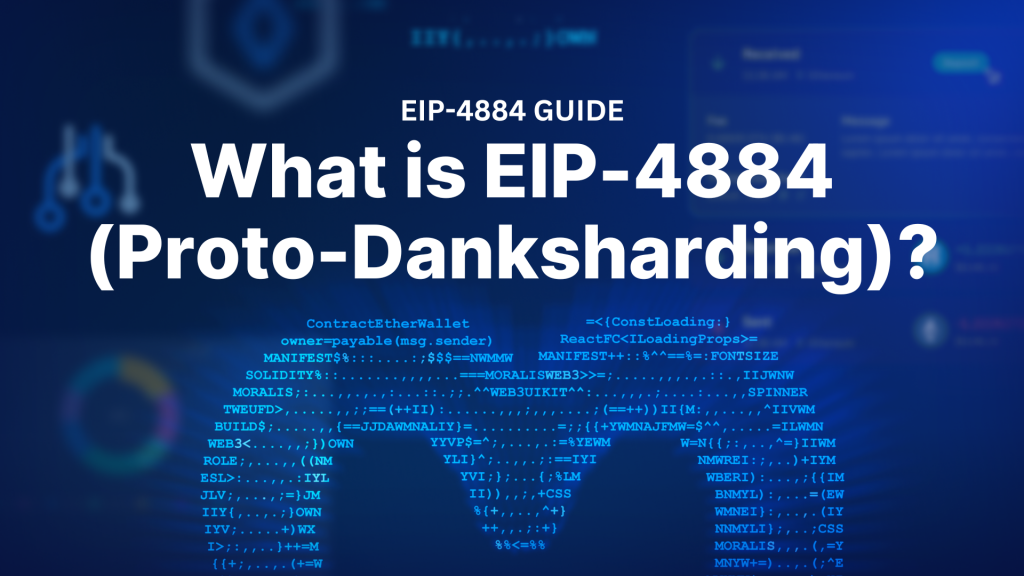
EIP-4844, or proto-danksharding, represents a promising expansion in the Ethereum protocol. Its primary goal is to tackle the pressing issues of high fees and limited transaction throughput, and it aims to do so by introducing a novel transaction type capable of handling data “blobs”. Furthermore, this upgrade is a vital stepping stone toward achieving full danksharding in the future, which is the key to empowering Ethereum to handle global transaction network demands. As a Web3 developer, staying updated and understanding new developments, such as EIP-4844, is critical. So, follow along as we dive deep into this Ethereum Improvement Proposal and closely examine proto-danksharding!
Overview
We will start today’s article by reviewing the basics of EIP-4844. As a result, you’ll first learn what EIP-4844 is. And, to help you see the big picture, we’ll also quickly cover Ethereum’s journey leading up to this new EIP. Aside from covering the improvement proposal’s basics, we’ll also look at its mechanics and potential benefits.
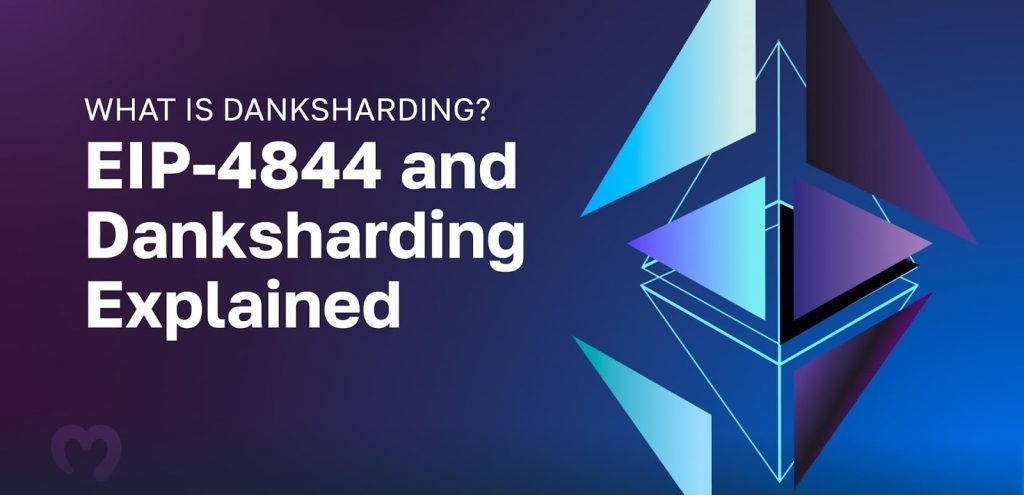
If you are new to Ethereum scaling solutions, we’ll also answer the questions, “What is sharding?” and “What is Proto-Danksharding?”. Additionally, you’ll get to learn all you need to know about “blob” transactions.
Last but not least, we’ll also take a closer look at the EIP-4844 timeline for implementation.
What is EIP-4844?
EIP-4844 (a.k.a. proto-danksharding) is one of the most eagerly anticipated Ethereum developments. This Ethereum Improvement Proposal (EIP) is poised to revolutionize the Ethereum network. It promises reduced transaction fees and a significant boost in transaction throughput. That said, what exactly is EIP-4844, and why is it generating such excitement?
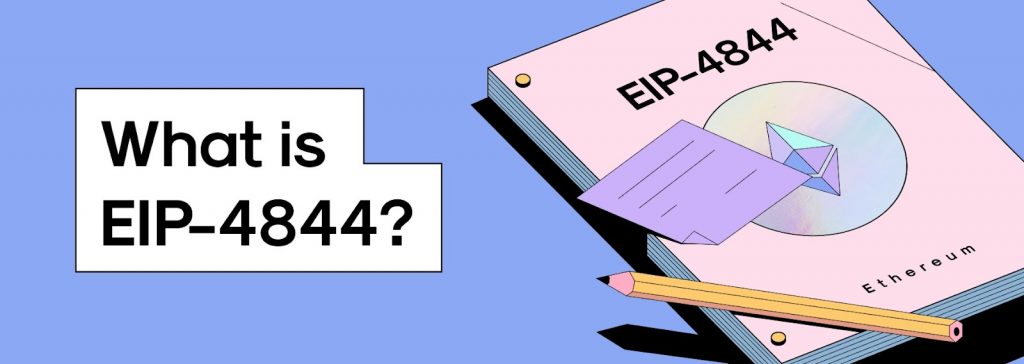
Ethereum’s Journey to EIP-4844
Before diving into the intricacies of EIP-4844, it’s essential to grasp Ethereum’s evolution. The transition from proof-of-work (PoW) to proof-of-stake (PoS) was a monumental milestone achieved in 2022. This transition set the stage for Ethereum to enhance its scalability and performance.
Ethereum’s architecture has been through a series of upgrades and transformations. Ethereum’s Beacon Chain, introduced in 2020, was the initial step toward the PoS architecture. However, it wasn’t until the Paris upgrade in September 2020 – commonly known as “The Merge” – that Ethereum fully embraced PoS. This upgrade involved separating the execution client from consensus clients, a crucial change to enable the network’s growth.
But Ethereum’s journey towards scalability didn’t conclude with the shift to PoS. The next ambitious phase involves implementing “sharding” (you can read more about sharding below). This approach holds the key to Ethereum’s ability to scale while maintaining its commitment to decentralization and security.
The Basics of EIP-4844
EIP-4844 aims to introduce a significant part of the framework and logic essential for successfully deploying full danksharding. The latter is a particular sharding approach coined by Dankrad Feist. That said, EIP-4844 won’t implement sharding itself, but it does serve as a vital stepping stone to enhance the scalability of layer-2 rollup solutions without waiting for full sharding.
Mechanics
At its core, EIP-4844 introduces a new transaction type that includes a data field called a “blob”. These blobs, which can be thought of as opaque byte strings, can reach a size of approximately 125 KB. They are secured using KZG, a novel cryptographic commitment scheme. That ensures data availability and alleviates the network’s burden from ever-expanding block sizes and unsustainable transaction gas costs.
These blob-carrying transactions offer layer-2 (L2) solutions a more efficient and cost-effective way of retrieving and querying data compared to traditional call-data methods. Importantly, blobs are stored exclusively in the consensus layer, primarily within Beacon nodes. This segregation from the execution layer (EVM) creates a separate fee market independent of the traditional gas market used to pay for transactions.
Once EIP-4844 becomes a reality, the impact will be most profoundly felt by L2 solutions (e.g., Polygon, Arbitrum, Optimism, etc.). Transactions posted to the layer-1 (L1) Ethereum network will become significantly more cost-effective. This should result in a more accessible and attractive experience for end-users.

Note: For a technical deep dive, make sure to explore the original EIP-4844 document. The latter awaits you on the “eips.ethereum.org” subdomain, as outlined in the above image.
Benefits
EIP-4844 represents a substantial leap forward for Ethereum, taking it one step closer to the full realization of sharding. While this upgrade begins by empowering layer-2 solutions, its long-term impact is equally noteworthy. As such, let’s look at the main potential benefits of this improvement proposal:
- Lower Transaction Costs: EIP-4844 aims to drastically reduce gas fees. This will make Ethereum transactions more affordable for all users, especially for those engaged with L2 solutions.
- Enhanced Scalability: The introduction of blobs and the associated changes pave the way for Ethereum to scale its transaction throughput significantly. This scalability is key to Ethereum’s quest to onboard the first billion users.
- Improved User Experience: Lower fees and increased scalability translate into a better user experience, attracting a broader audience to the Ethereum ecosystem.
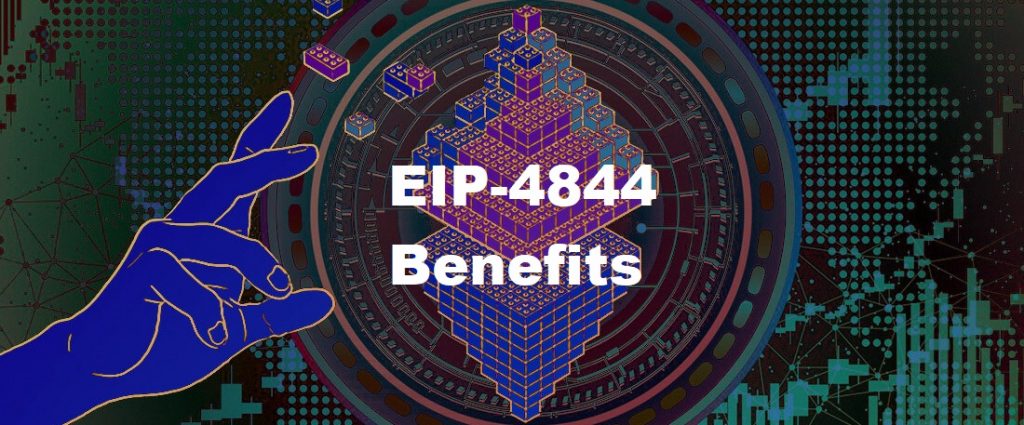
It’s crucial to note that, at the time of writing, EIP-4844 is still in the proposal stage and awaits implementation on the Ethereum mainnet. Despite its promising potential, the precise timeline for its deployment remains subject to potential delays. However, we will offer some additional insights regarding the EIP-4844 timeline for implementation further down this article.
In the ever-evolving landscape of blockchain technology, EIP-4844 stands as a critical development that promises to make Ethereum more accessible, efficient, and attractive for users and developers alike. As Ethereum continues its journey toward greater scalability and cost-effectiveness, EIP-4844 serves as a beacon of hope for a brighter, more inclusive future in the world of blockchain.
What is Sharding?
Sharding is a revolutionary concept in blockchain technology, with particular significance in the Ethereum ecosystem. It’s a strategy to address one of the most pressing challenges facing blockchain networks: the trade-off between decentralization, security, and scalability. So, sharding offers a solution that aims to strike a balance between these crucial elements.

The concept of sharding has its roots outside crypto. After all, it’s been developed around traditional databases. In that aspect, sharding distributes a single dataset across multiple machines.
In blockchain, sharding refers to a method of dividing the network into smaller groups or “shards” to process transactions in parallel. Sharding is particularly vital for Ethereum’s sibling chains, like layer-2 rollups, which rely on Ethereum for data storage. The cost associated with submitting data to Ethereum has been a concern, making sharding a highly anticipated upgrade.
All in all, the main goal of sharding is to scale the Ethereum network without compromising its core principles of decentralization and security. By dividing the network into smaller, manageable units, each shard can process transactions independently. This approach results in parallel processing, effectively increasing the network’s capacity.
Sharding Benefits Beyond Ethereum
Sharding isn’t exclusive to Ethereum. It’s a concept that can potentially transform the entire blockchain space. As blockchains can handle a larger number of transactions at lower costs, they become more appealing for a wide range of applications, including decentralized finance (DeFi), non-fungible tokens (NFTs), supply chain management, and more.
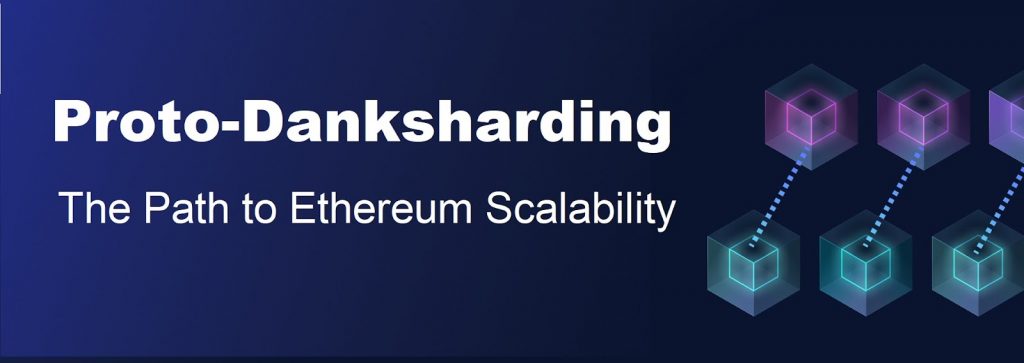
What is Proto-Danksharding?
Proto-dansharding is just another, less technical name for EIP-4844. Furthermore, proto-danksharding is an integral part of Ethereum’s ongoing evolution. It is a crucial step in the path toward achieving the coveted goal of a highly scalable and cost-effective blockchain.
As such, it is a significant upgrade proposed as Ethereum transitions from its existing infrastructure to a more efficient and user-friendly network, particularly for layer-2 transactions.
The name “proto-danksharding” is derived from its two visionary creators, Protolambda and Dankrad Feist. This intermediate solution, represented by EIP-4844, aims to optimize L2 transactions by making them significantly cheaper for users. Its primary focus is on reducing the cost of transactions, enabling the Ethereum network to handle over 100,000 transactions per second (TPS).
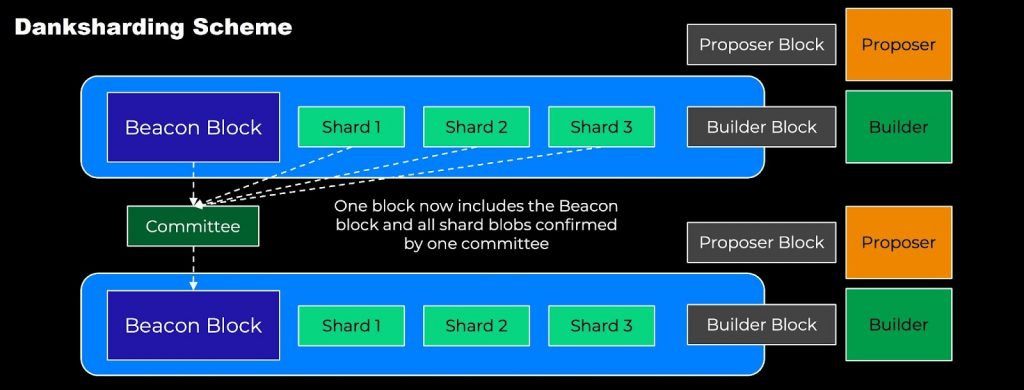
Danksharding Explained
Danksharding is Ethereum’s transformative leap into scalability. It builds on the foundations laid by proto-danksharding to create an ecosystem where rollups can efficiently store their transaction data.
By expanding data blobs from one to 64 in full danksharding, Ethereum opens the door to supporting numerous rollups with ease. This means that millions of transactions per second are no longer a dream but a tangible reality in the world of blockchain. Danksharding’s arrival heralds a new era of Ethereum, underlining its commitment to innovation and scalability.
Essentially, danksharding is the ultimate vision, aiming to allocate a substantial amount of space within Ethereum for rollups to store their compressed transaction data. This development will empower Ethereum to solve its current scalability issues.
Danksharding will expand upon the concepts introduced in proto-danksharding by increasing the number of data blobs attached to blocks, further optimizing Ethereum’s scalability. In addition to these improvements, it necessitates changes to the operation of consensus clients, enabling them to handle larger data blobs.
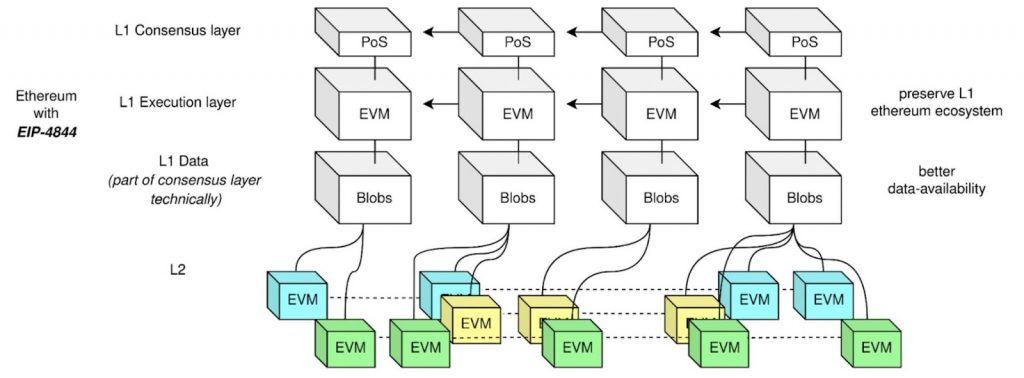
What are EIP-4844 Blob Transactions?
Blob transactions are a groundbreaking concept in Ethereum’s journey towards scalability. These transactions are not your typical blockchain interactions but rather a novel approach to handling data. When we talk about blobs, we’re referring to bundles of information. You can think of blobs as encrypted capsules attached to Ethereum blocks.
Unlike regular transactions, blob transactions don’t carry out direct computations on the EVM (Ethereum Virtual Machine). Instead, blobs serve as data reservoirs that can be efficiently stored on the consensus layer of the Ethereum network. This means that the virtual machine is blissfully unaware of blobs’ existence, and the data they hold is immune to its prying eyes. Moreover, blobs have an expiration date, a feature that differentiates them from traditional transactions. After a set period, usually ranging from one to three months, these blobs self-destruct. This built-in obsolescence ensures that Ethereum’s blockchain isn’t burdened with endless data. It’s a bit like the messages in a spy movie that vanish after a certain time, leaving no trace behind.
The introduction of blob transactions via EIP-4844 is a pivotal step in cost reduction and enhanced scalability of Ethereum. This will allow rollup solutions to post their data more economically within these blobs, offering users cheaper transactions and significantly lowering the barriers to entry for Ethereum’s burgeoning ecosystem.
EIP-4844 Timeline for Implementation
Ethereum’s journey towards sharding involves a two-step process. The first phase, known as EIP-4844, serves as a transitional upgrade to prepare the network for full sharding. While it doesn’t implement sharding, it introduces critical elements like blob-carrying transactions to enhance the network’s scalability and cost-effectiveness. So, obviously, the EIP-4844 timeline for implementation is an important topic.
The second phase, known as danksharding, is the ultimate goal. Danksharding aims to enable Ethereum to process a remarkable 100,000 transactions per second (TPS), a monumental increase compared to the base layer’s current TPS of around 15.
While the full realization of danksharding is a few years away, EIP-4844 is making rapid progress, with the KZG ceremony involving tens of thousands of contributors. The EIP for proto-danksharding is mature, its specifications have been agreed upon, and client prototypes are being tested and prepared for production. The next step involves implementing these changes on a public testnet, bringing Ethereum one step closer to achieving its scalability and cost-efficiency goals.

The above image indicates the initially proposed EIP-4844 timelines for implementation. However, as usual, Ethereum upgrades tend to experience some delays. Still, since the Shanghai upgrade was successfully executed in March 2023, the ground is set for EIP-4844 implementation. While the clear date hasn’t yet been announced, we can expect this upgrade to go live before the end of 2023.
Key Takeaways: What is EIP-4844? All You Need to Know About Proto-Danksharding
- EIP-4844 (a.k.a. proto-danksharding) is an Ethereum Improvement Proposal (EIP) set to revolutionize Ethereum. It promises to reduce transaction fees and significantly boost transaction throughput.
- Ethereum transitioned from proof-of-work (PoW) to proof-of-stake (PoS) in 2022, a significant milestone that laid the groundwork for enhanced scalability.
- Sharding is the next ambitious phase in Ethereum’s evolution. It involves dividing the network into smaller “shards” to process transactions in parallel.
- While not full sharding, EIP-4844 serves as a vital step in enhancing scalability. It introduces “blobs” in transactions, making Ethereum more efficient and cost-effective for layer-2 rollup solutions.
- Danksharding is the end goal that will allow Ethereum to handle millions of transactions per second, enhancing scalability and innovation.
- Blob transactions are innovative data storage methods that improve cost-effectiveness and scalability, as they don’t burden Ethereum Virtual Machine (EVM).
- Despite some delays in the EIP-4844 timeline for implementation, things are progressing rapidly. With the KZG ceremony and client prototypes, EIP-4844 should go live before the end of 2023.
EIP-4844 represents a significant step toward making Ethereum more accessible, efficient, and appealing to users and developers. It signifies Ethereum’s journey towards greater scalability and cost-effectiveness. This will help attract new users into the realm of cryptocurrencies and decentralized applications (dapps). As such, now is still a great time to focus on Web3 development. And, building dapps is already as straightforward as it gets. Thanks to Moralis’ enterprise-grade APIs and real-time blockchain data, Web3 development is as easy as Web2. Moreover, you can create a killer dapp with a free Moralis account!
To learn more about Moralis’ Web3 API products (NFT API, Token API, Market Data API, Price API, etc.) and their applications, visit the Moralis blog or dive straight into the platform’s documentation.
